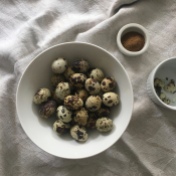Making apéritif alcohol infusions isn’t the peak or culmination of proficiency and dedication in the kitchen. Just the opposite. Few things are as easy as cutting fruit, scooping sugar, and pouring over some strong alcohol. Everyone should try it, especially anyone who wouldn’t touch a kitchen appliance with a ten-foot pole. Unlike preserving or canning, which usually involves quite a bit of prep, macerating, simmering, and sterilising of jars, not to mention the faintest hovering threat of serious poisoning, here there is no risk attached, the combination of sugar and strong alcohol makes sure of it.
One of my oldest friends, who is possibly also one who cooks the least, has been infusing rum with fruits, spices, herbs — even, I think, vegetables! — for decades. Many start as experiments, none follow a measured recipe. She has a whole trunkful at home, dozens and dozens of bottles. For years, every time we saw her, she also brought along a bottle (or two or three) of prunelle (sloe liqueur), made by her mother, who wasn’t, I understand, a particularly enthusiastic cook either. She had quite a way with prunelle, though.

This is where I got the hint. When I want to make something but have neither much time, nor much patience, I seep fruit in alcohol. And so we have jars of fruit-seeped alcohol — and alcohol-seeped fruit — in every corner of the kitchen. I have now taken up the mantle of prunelle production, I’ve made Seville orange gin, I have a traditional rum pot macerating with summer fruit, and another with dried fruit. I’ve even experimented with quince, though the ratafia needs some fine tuning.
Vin d’orange, a delicately flavoured bitter-orange apéritif originally from the South of France, is just such a project — ridiculously quick and easy. All it needs is a bit of patience (a few weeks at least), and, later, someone with whom to crack open a bottle.

Vin d’orange recipe adapted from Samin Nosrat
I tried a couple of different recipes for vin d’orange last year. I like this one best with just rosé and vodka. I’ve adjusted quantities, the recipe remains pretty much the same.
A large, closeable glass jar with a capacity of 3 litres (and later 3 clean sealable 750ml bottles)
4 Seville oranges
1 orange
1/2 lemon
180g to 200g sugar
1 vanilla bean, cut in half lengthwise
1.5 litres (= 2 bottles) of rosé wine (cheap but drinkable!)
350ml (= half a bottle) of vodka
Wash and dry the jar with a clean cloth.
Rinse all the citrus, cut them it into smallish chunks.
Place all the fruit into the jar. Add the sugar and vanilla bean, and pour in the alcohol. Mix well but gently until the sugar dissolves. Seal tightly and leave in a cool, dark place (or the fridge, if there is room!) for about a month. (Samin Nosrat suggests between 32 and 40 days, but I am pretty sure I left mine quite a bit longer last year. Whatever suits, it’s far from a perfect science!)
After about a month, when the vin d’orange has developed the right orangey and bitter taste, strain the liquid through a fine mesh sieve lined with two layers of cheesecloth into clean sealable bottles. The vin d’orange is now ready to drink, and will only get better and better.
Serve chilled, with friends.
















